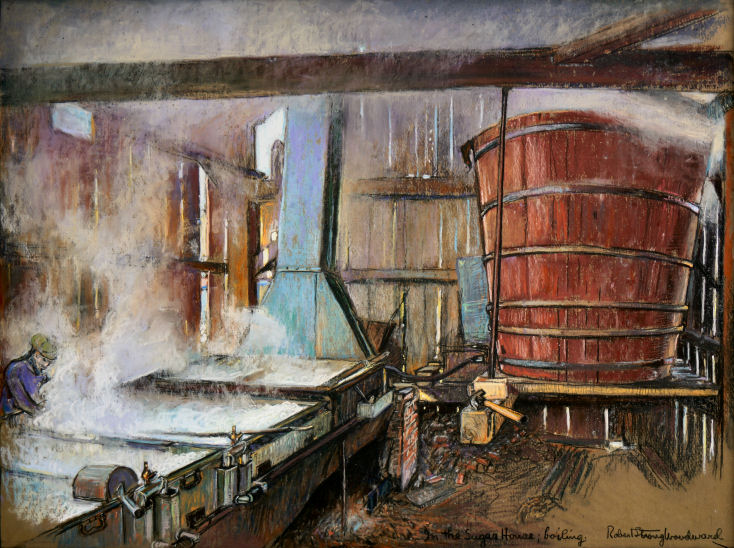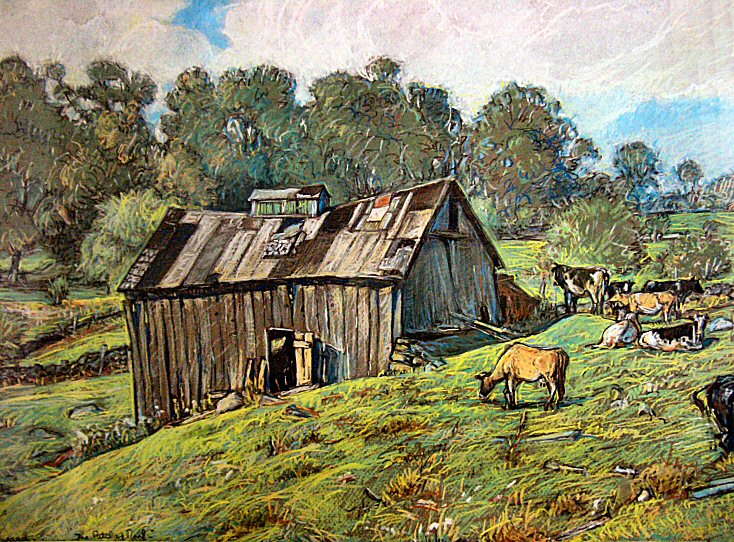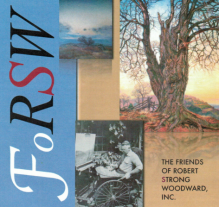Quick Reference
1928-'29
Unknown
Oil on Canvas
Landscape
Sugaring, Woods
25 x 30
Unknown
Mrs. Josephine Pettingill Everett
Click Here
Related Links
Featured Artwork: Gathering Sap
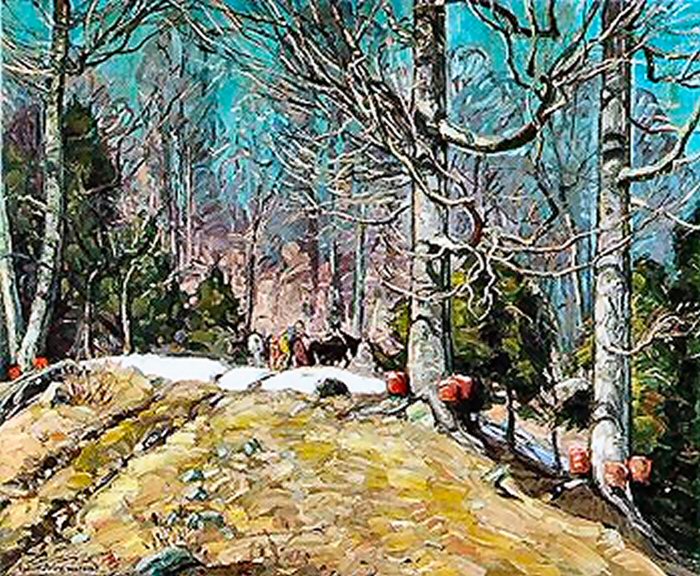
RSW's Diary Comments
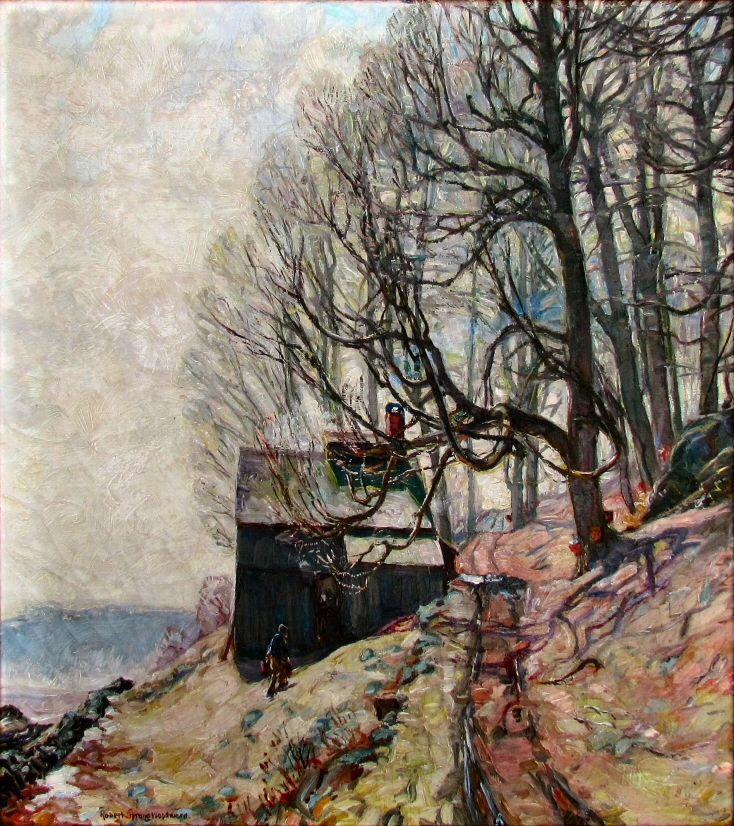
 Steaming Sugar House, 1929, shows "the steep
Steaming Sugar House, 1929, shows "the steep
perilous road" of Herbert Keach's sugar orchard
Diary Comments from Sap Gathering
"I think painted in the late 1920's. One of my early canvases painted high, on the steep perilous road of Herbert Keach's sugar orchard. Bought prior to 1930 by Bob Kerr, then of Holyoke, now of 150 Highland Ave., Montclair, N. J. (Mr. and Mrs. Robert Kerr)."
Editor's Note:
There are two themes associated with this painting and that of similar scenes found in 1927s
When Drifts Melt Fast the "best landscape" from the 1928 Springfield Art League's annual show.
Sometime around the mid-1920s,
after his disastrous Regate Studio fire, the artist began his study of Keach brothers respective farms, Herbert being the first with
The Friendly Doorway, 1924.. Around the same time RSW took a strong interest in the "sugaring " process as a subject of study
from its collection to the boiling. As a subtext to both themes, interiors present themselves frequently. From inside the sugar house to barn interiors.
Following the success of the well traveled When Drifts Melt Fast RSW made two more smaller paintings,
Sap Gathering and Gathering Sap above.
Additional Notes
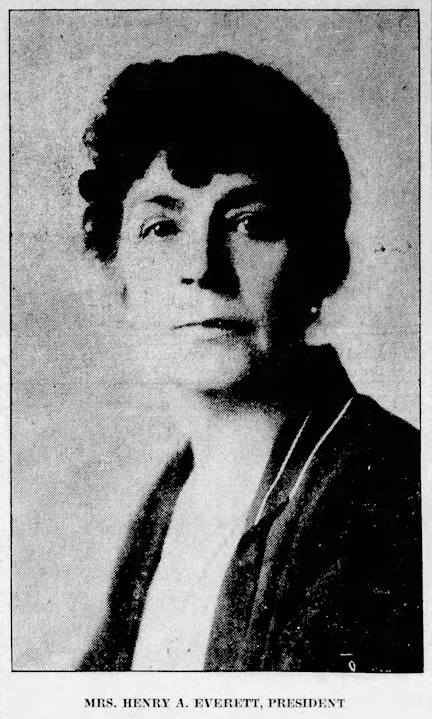
 The only photograph of Mrs. Everett
The only photograph of Mrs. Everett
we could find after and exhaustive search.
Published in the Pasedena Evening Post
June 22, 1928. She is 62 year old in the clip.
 This painting was likely made specifically for
Mrs. Everett who Woodward has probably known since he was a young boy living in Ohio and later Pasadena, California. We say maybe because we do not
know for sure. Here is what we do know... Mrs. Everett's husband Henry was in the small rail industry in Cleveland. Things like trolleys or what we know today
as commuter rails. Due to the high operating cost of these businesses, they were rarely profitable yet it is also the driving force that happens to build this country.
Small rail systems run on electricity and so many of these systems were owned by the power companies or real estate developers or both.
This painting was likely made specifically for
Mrs. Everett who Woodward has probably known since he was a young boy living in Ohio and later Pasadena, California. We say maybe because we do not
know for sure. Here is what we do know... Mrs. Everett's husband Henry was in the small rail industry in Cleveland. Things like trolleys or what we know today
as commuter rails. Due to the high operating cost of these businesses, they were rarely profitable yet it is also the driving force that happens to build this country.
Small rail systems run on electricity and so many of these systems were owned by the power companies or real estate developers or both.
The profits
are in the land, and Woodward's father Orion, was a prominent real estate developer with ties to several recognized historic neighborhoods in both Ohio and California.
The Woodwards and Everetts lived in both locations. Orion is in real estate and Henry is a pioneer in the small rail, trolley industry... and Mrs. Everett is a famed art
collector who happens to buy at least nine paintings from Woodward that we know about.
Woodward knew Mrs. Everett well enough to visit with her at
her hotel in New York City when she was in town to attend the annual Watercolor Society's exhibition, for which he was a member.
 Aside from her famed art collection, Mrs. Everett's greatest contribution to the arts may just be the Hollywood
Bowl. She is reportedly the person who wrote the check to buy the land it resides on to this day.
Aside from her famed art collection, Mrs. Everett's greatest contribution to the arts may just be the Hollywood
Bowl. She is reportedly the person who wrote the check to buy the land it resides on to this day.
 The image of this painting above is from the 1996 auction that sold the painting. It is the only resolution
picture we have and the painting's location is unknown.
The image of this painting above is from the 1996 auction that sold the painting. It is the only resolution
picture we have and the painting's location is unknown.

